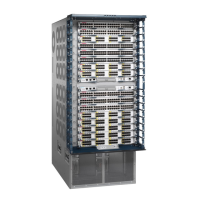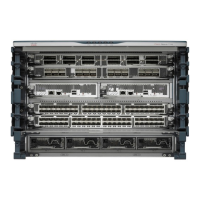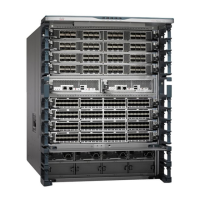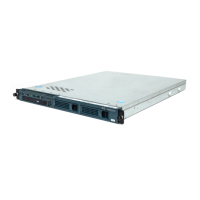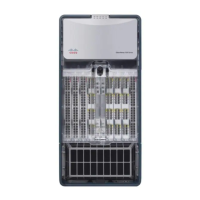Maintenance 5-181
Installing and Configuring Processor Modules
Step 7 Initialize the router by entering the i command as follows:
> i
The router will power cycle, the configuration register will be set to 0x141, and the router
will boot the boot ROM system image and prompt you with the system configuration dialog
as follows:
--- System Configuration Dialog ---
Step 8 Enter no in response to the system configuration dialog prompts until the following system
message is displayed:
Press RETURN to get started!
Step 9 Press Return. After some interface information, the prompt appears as follows:
Router>
Step 10 Enter the enable command to enter the EXEC mode. The prompt changes to the following:
Router#
Step 11 Enter the show configuration EXEC command to display the enable password in the
configuration file and to display any boot system commands.
Step 12 Enter the configure terminal command at the EXEC prompt. You are prompted as follows:
Router# conf term
Enter configuration commands, one per line. End with CTRL/Z
Step 13 Enter no in response to any boot system command in the configuration file.
Step 14 Using the config-register 0x<value> command, change the configuration register value
back to its original value (noted from Step 3) or change it to a value of 0x0101 (factory
default).
Step 15 Exit configuration mode by entering Ctrl-Z.
Step 16 Reboot the router and enable it using the recovered password.
Saving and Retrieving the Configuration File
This section describes the procedures for saving and retrieving the system configuration using a
Trivial File Transfer Protocol (TFTP) server.
The procedures for saving and retrieving the configuration file might be required for the following
scenarios:
• Upgrading the Cisco 7000 to operate with the 7000 Series Route Switch Processor (RSP7000),
which requires you to remove the RP (and SP or SSP) and replace them with the RSP7000 and
7000 Series Chassis Interface (RSP7000CI). Removing the RP effectively removes the
configuration file that is stored in the RP’s NVRAM, making it necessary to first save the
configuration file to a TFTP server. In addition, you cannot read the RP’s Flash card with the
RSP7000. This requires that you use a TFTP server to save and retrieve the file.
• Replacing a failed RP (or RSP7000), which requires you to remove the RP (or RSP7000) and
install a new processor module. Removing the RP (or RSP7000) effectively removes the
configuration file that is stored in NVRAM, making it necessary to first save the configuration
file to a TFTP server. You can also use the procedures for copying files between NVRAM and a
Flash memory card.

